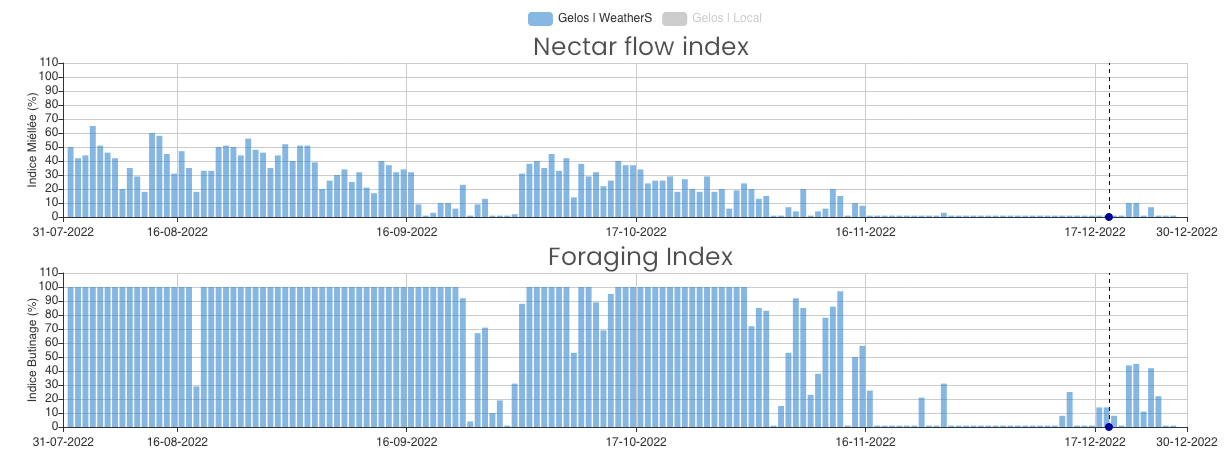If you ask a knowledgeable beekeeper what happens in the hives at the end of the season he will answer something like this:
Of course, these outlines from experience seem reasonable, but what happens actually in my apiary?
That's what we will explore in this post.
Resource analysis
Looking at the Productivity (comparing gross weights makes little sense) since the beginning of August we see that the hives lost weight for 2 months, until September 30. Then, during 15 days, the contributions came to compensate the losses in a considerable way (all hives are not equal). And again, from October 17 we have resumed the downward slope.

This "autumn nectar-flow" was possible because the weather at this time was favorable: Foraging Index at 100% and Nectar-flow Index at 40% (almost like in summer!?). I have some ivy in my area, but also some Japanese medlar and arbutus. I did not go to see which one was flowing at that time, I skipped it. Next year I will pay more attention to it!

It must be said that at that time I was more concerned by the pressure of hornets. In my sector it was at its peak in mid-August. When we see the bees in cluster on the flight board, we are quickly prone to think that the bees do not go out anymore! Here we have the proof that despite the pressure of the hornet, the bees managed to navigate.
Why this resumption?
What happened this autumn in the southwest of France is not quite normal (if there is still such a thing as recurrent "normality"). We had an upwelling of warm air from southern Europe which was combined with a Foehn Wind which reinforced it in the Pyrenean sector. This phenomenon, well known by the wine growers of the Jurançon terroir who make the late harvest, consists in the heating of an air mass when crossing over a mountain.

Brood analysis
When I looked at the brood trajectory around Sept 20, I thought we were heading straight for an egg laying halt. This was the case for some hives. But in early October the queens went back to work for a last batch of winter bees. The abnormally high temperatures have boosted the egg laying and certainly the nectar flow of some surrounding plants!

This period of brood production lasted about one month, from October 5 to November 5. Then, around November 8 we measured the cessation of egg laying in several hives. November 8 is a bit early for a laying stop, isn't it? At this date the minimum temperatures never went below 10°C (50°F). But it seems that the queens having finished their batch of bees do not want to start another series. The result is the cessation of egg laying at a time that is still dominated by a certain mildness.
At the apiary it will still be between 8°C (46F) and 15°C (59F) for two weeks and then from November 19th it will cool down a bit more.

So clearly the egg-laying stop in 2022 happens early November. To give a reference, in 2021 the egg-laying stop took place -almost- on December 8, one month later. And it was followed by an immediate resumption of egg-laying, also because of a " heat wave " coming from Spain from mid-December until Christmas.
Oxalic GO !
In seeing these elements, the winter treatment should be triggered as early as November 10th. Seize the opportunity to reduce the varroa pressure as soon as possible. But also to prevent against a possible resumption of egg-laying triggered by a December thaw as we saw in 2021.
Conclusion
This example taken from a real case, shows us that the dynamics of the apiary is part of a complex system. It is strongly modulated by the weather and resources, even in autumn. History effects come into play which are not always perceptible to the naked eye, even less so at this time of year when the hives are rarely opened.
As I see examples like this, I am more and more convinced that the queen is programmed to launch "batches" of bees rather than to lay eggs "on the fly" . Basically, she would engage in a period of production and then stop, perhaps modulated by the weather but not necessarily because of it (it's a subtle difference that matters.)
Monitoring tools allow an informed insight into these events. They synthesize the past evolution and allow to understand the overall brood/resource/weather interactions (as long as you have something more than a scale in your apiary).
The strength of the method is to start from a formal and daily measured data set in order to build, from it, a rationale enriched with the beekeeper's experience.
Of course, one can always try to work in the old way and record in memory some key facts and events that will serve to build a hypothetical scenario that nobody will be able to contradict (not even oneself). This may have worked in the past, but we are no longer in the same context.
But let's not forget the most important thing: continuous monitoring allowed here to act just in time.
The oxalic treatment was triggered on November 10, and that’s a big deal for bees!

